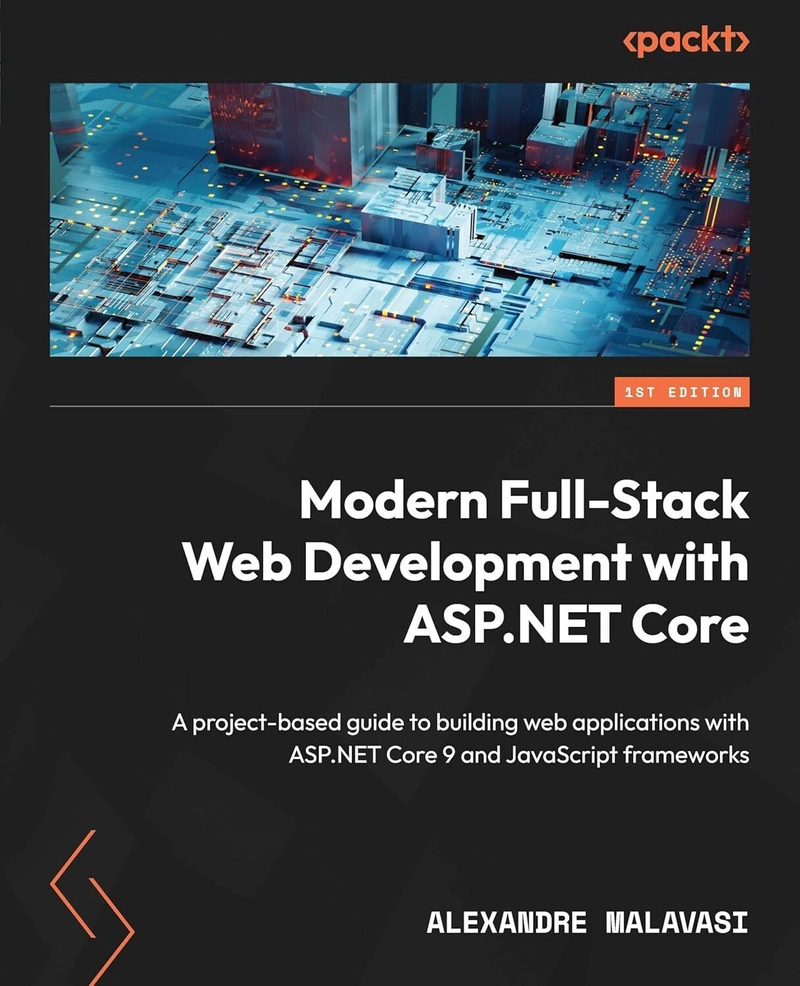Sharing the chapter-wise summary with +learning in each chapter from Modern Full Stack Web Development with ASP.NET Core by Alexandre Malavasi
Chapter 1, Introduction to ASP.NET Core, covers the basics of ASP.NET Core, exploring its architecture, key features, and available project templates. By the end, you’ll understand its history and build a simple web application, preparing you for more advanced topics in the following chapters.
Chapter 2, Setting Up and Building Basic Applications, guides you through setting up your ASP.NET Core development environment and creating your first web application. You’ll learn the essentials of the Model-View-Controller (MVC) architecture, as well as routing and controllers, which are fundamental to building and navigating applications. By the end, you will have a functional ASP.NET Core app and a solid foundation for future development.
Chapter 3, Middleware and Dependency Injection, explores two core concepts of ASP.NET Core: middleware and dependency injection. You’ll learn how to implement middleware to customize the request pipeline and manage services efficiently using dependency injection. By the end, you’ll be equipped to build adaptable, maintainable applications with clean and scalable code.
Chapter 4, Configuration and Security, covers the essentials of configuring ASP.NET Core applications across different environments, ensuring flexibility and reliability. You’ll also dive into authentication
and authorization, learning to secure your applications against unauthorized access. Additionally, you will explore secure data-handling practices and implement SSL to protect data in transit. By the end,
you’ll have the skills to build secure, adaptable applications that are ready for modern web challenges.
Chapter 5, Introduction to Blazor, explores Blazor, a framework that allows you to build interactive web UIs using C#. You’ll learn how to create a basic Blazor WebAssembly application and discover the differences between client-side and server-side Blazor. Additionally, you’ll dive into Blazor’s component architecture and data binding, equipping you to build dynamic, responsive web applications.
Chapter 6, Advanced Blazor Development, dives into advanced Blazor topics, including component architecture and lifecycle. You’ll also learn how to handle events in Blazor to create responsive UIs, and master state management techniques to ensure your applications maintain smooth and consistent functionality. By the end, you’ll be equipped to build more complex, high-performing Blazor applications.
Chapter 7, Advanced Component Architecture in Blazor, explores advanced Blazor component architecture. You’ll learn to create dynamic components, manage complex UIs, and handle advanced routing with parameters. You’ll also dive into JavaScript interoperability, allowing you to integrate JavaScript libraries with Blazor. Finally, you’ll discover the new render modes in Blazor (.NET 8), optimizing performance and user experience in your applications.
Chapter 8, RESTful Services with ASP.NET Core – Part 1, introduces the foundational concepts of RESTful services and guides you through building basic REST APIs using ASP.NET Core. You’ll learn the principles of REST, how to create and configure APIs, handle requests and responses, and
implement versioning and documentation. By the end, you’ll have the skills to build well-structured, maintainable REST APIs.
Chapter 9, RESTful Services with ASP.NET Core – Part 2, delves into more advanced aspects of REST API development, focusing on complex routing techniques and performance optimization. You’ll learn how to create flexible API endpoints and apply strategies such as caching and asynchronous programming to improve API efficiency. By the end, you’ll have the skills to build scalable, high performing APIs using ASP.NET Core.
Chapter 10, Introduction to JavaScript Frameworks, provides an introduction to the three most popular JavaScript frameworks: Angular, React, and Vue.js. You’ll learn the foundational principles of each
framework, explore their key features, and understand their use cases. By the end, you’ll be equipped to start working with these frameworks and apply them to simple web projects.
Chapter 11, Exploring Vue.js and Comparing Frameworks, takes a deeper look at Vue.js, covering advanced features such as state management, routing, and navigation. You’ll gain practical skills for
building more complex Vue.js applications while exploring how Vue.js compares to Angular and React. By the end, you’ll be well-equipped to build scalable Vue.js applications and choose the best
JavaScript framework for your projects.
Chapter 12, Integrating Vue.js with ASP.NET Core, focuses on integrating Vue.js with ASP.NET Core to build full-stack applications. You’ll learn how to manage data flow between the frontend and backend, implement secure authentication and authorization, and optimize your application’s performance. By the end, you’ll be ready to create efficient, scalable full-stack applications using these
two powerful technologies.
Chapter 13, Integrating Angular with ASP.NET Core, guides you through integrating Angular with ASP.NET Core to create scalable full-stack applications. You’ll learn how to set up both frameworks, implement secure API communication, and optimize performance. By the end, you’ll be equipped to build dynamic, high-performance applications using Angular for the frontend and ASP.NET Core
for the backend.
Chapter 14, Integrating React with ASP.NET Core, walks you through integrating React with ASP.NET Core to build dynamic, scalable full-stack applications. You’ll learn how to configure both technologies, establish efficient data communication, and optimize performance for a seamless user experience. By the end, you’ll have the skills to create high-performing full-stack applications using React for the frontend and ASP.NET Core for the backend.
Chapter 15, Planning and Structuring Full-Stack Projects, focuses on planning and organizing full-stack web projects to ensure both frontend and backend components work seamlessly. You’ll learn how to set project objectives, design scalable architectures, and apply version control strategies. Additionally, we’ll cover Agile methodologies for team collaboration, ensuring efficient project management from planning to deployment.
Chapter 16, Performance, Deployment, and Maintenance, explores critical strategies for optimizing the performance of full-stack applications, from backend efficiency to frontend responsiveness. You’ll learn deployment techniques to ensure smooth launches and post-deployment monitoring and maintenance practices to keep applications running at peak pe
rformance. The chapter also covers scaling applications to handle high traffic, ensuring long-term stability and growth.





Top comments (0)